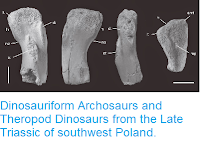The Tanystropheidae are a curious group of Triassic Archosauromophs (animals more closely related to Dinosaurs and Crocodiles than to Lizards and Snakes), which had a sprawling gait similar to that of modern Lizards or Crocodiles, combined with a slender body and an exceptionally long neck. This neck was comprised of a low number of greatly elongated vertebrae, thirteen in members of the genus Tanystropheus, in a similar way to that of modern Giraffes, suggesting that they had rather limited neck movement, which has made it difficult to understand the living ecology of these animals.
In a paper published in the journal Rivista Italiana di Paleontologia e Stratigrafia on 14 March 2018, Silvio Renesto of the Dipartimento di Scienze Teoriche ed Applicate at the Università degli Studi dell’Insubria, and Franco Saller of Gargazzone in the South Tyrol, re-examine the skeletal morphology of Tanystropheus, with a view to understanding its movement and therefore potentially its ecology.
Reconstruction of the skeleton of a large specimen of Tanystropheus longobardicus in walking posture. Scale bar equals 1m. Renesto & Saller (2018).
A specimen of Tanystropheus with hooklets from Belemnoid Cephalopod was discovered in the 1970s, leading to speculation that the animal may have been a swimming predator, similar to the later Elasmosaurs, but Tanystropheus lacked the musculature for constant swimming, making such a lifestyle impossible. Another suggestion was that it may have hunted in a similar way to a Heron, remaining motionless on the shore or in shallow water, and striking at prey with its long neck, but the neck of the animal was apparently to inflexible to allow for such a mode of life.
Renesto and Saller re-examined the skeleton of Tanystropheus, and observed that the hindlegs were considerably longer than the hindlimbs, and that the hindquaters and tail appear to have been much more heavily muscled than the rest of the body, which they suggest implies that the hindlinbs and tail were the main drivers of locomotion in the living animal.
Tanystropheus longobardicus (A) transversal section the base of the tail with reconstruction of the pattern of the muscles; (B) transversal section at mid tail; (C) reconstruction of the development of the caudofemoralis longus in ventral view; (D) reconstruction of the caudofemoralis longus (dark grey) and ilioischioocaudalis (light grey) in lateral view; (E) path of the main leg muscles in Tanystropheus. Abbreviations in (E): cfb, caudofemoralis brevis, ft, femorotibialis, g, gastrocnemius, ife, iliofemoralis, ifi, iliofibularis, pife, puboischiofemoralis. Renesto & Saller (2018).
Due to the elongate body of Tanystropheus, any form of locomotion relying on alternate strokes of the hindlimbs would probably have been extremely unstable, however if the hindlimbs were pulled forward to their full extent and then pushed back simultaneously, then they could have delivered a powerful backward kick, enabling the animal to push off the shore or another vantage point, or drive a short burst of powerful swimming.
Sketch representing Tanystropheus diving quickly into water by symmetrical stroke of the hind limbs starting from resting position. Renesto & Saller (2018).
Renesto and Saller suggest that this motion would have made Tanystropheus an effective ambush predator, able to strike rapidly at aquatic prey from either the shore or a vantage point in the water, with its small head and slender neck disguising its true size from its prey until a stroke of the hindlimbs drove it forward rapidly in a striking motion.
Reconstruction of Tanystropheus swimming in shallow sea. Renesto & Saller (2018).
See also...
Follow Sciency Thoughts on Facebook.










